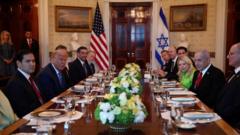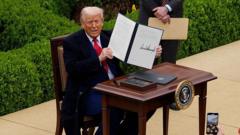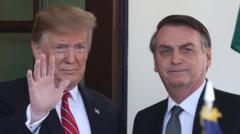President Trump has confirmed a 25% tariff set to impact South Korean and Japanese exports, effective August 1. The announcement, perceived negatively by markets, follows a series of tariff threats directed at various countries, as negotiations with Japan and South Korea lag due to previous elections and ongoing tariffs on major exports.
### Trump Implements New Tariffs on Asian Allies

### Trump Implements New Tariffs on Asian Allies
In a significant shift in trade policy, President Trump has announced a 25% tariff on exports from South Korea and Japan, along with other tariff threats against multiple nations.
In a bold move on July 7, 2025, President Trump declared new tariffs aimed at South Korea and Japan, implementing a sweeping 25% levy on their exports effective from August 1. This announcement came as part of a broader strategy to reevaluate the United States’ trade relationships, particularly with countries that have significant trade surpluses with the U.S.
The immediate response from the financial markets was a negative one, reflecting concerns that these tariffs are exceptionally high for two of America’s largest trading allies. Investors seem wary of the potential ramifications on trade dynamics, particularly in light of recent discussions around trade deals that have yet to yield concrete agreements.
In addition to the new tariffs for South Korea and Japan, Trump expanded his tariff threats, proposing 40% on Myanmar and Laos, 30% on South Africa, and 25% for Kazakhstan and Malaysia. His administration has been engaged in trade negotiations for the past 90 days, managing to secure preliminary agreements only with Britain and Vietnam, leaving the future of other trade discussions uncertain.
Negotiations with Japan and South Korea have proven to be more complex, slowed down by recent elections in both nations, and the looming threat of additional tariffs on key exports, including automobiles and electronics. These factors have made both countries hesitant to finalize trade deals, as they fear further economic penalties from the U.S. down the line.
As the situation unfolds, many are closely watching the potential impact on not only the economies of South Korea and Japan but also on the global trading landscape as a whole.


















